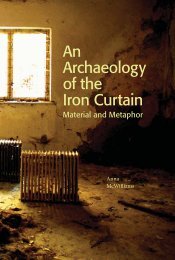You also want an ePaper? Increase the reach of your titles
YUMPU automatically turns print PDFs into web optimized ePapers that Google loves.
55<br />
AN ILLUSTRATION TO THE SAT SAI <strong>OF</strong><br />
BIHARI: TOSSING A FLOWER<br />
GARHWAL, NORTH <strong>INDIA</strong>, CIRCA 1790-1800<br />
Opaque pigments heightened with gold on paper,<br />
Krishna and Radha play at throwing a fower at<br />
each other, the scene set in a palace courtyard,<br />
a female attendant watches the scene from the<br />
left, a herd of cows approaches a city by a lake in<br />
the background, with foral illuminated spandrels<br />
on yellow ground, within white rules with red and<br />
blue borders, the reverse with text in takri and<br />
devanagari scripts<br />
9æ x 7in. (24.8 x 18cm.)<br />
£10,000-20,000 $15,000-28,000<br />
€13,000-25,000<br />
PROVENANCE:<br />
Acquired from Colnaghi, London, 1 September<br />
1980<br />
The Sat Sai or ‘seven hundred’ verses is an early vernacular text written in the early Braj Bhasha proto-dialect of Hindi. It follows in the tradition of religious texts<br />
focusing on the romance of Krishna and Radha. The work itself contains couplets on neeit (moral lessons), shringara (love) and most importantly bhakti (devotion).<br />
Bihari was a poet at the court of Mughal Emperor Shah Jahan who was later invited by Raja Jai Singh of Amber to move to his court. It is at Amber that Bihari is<br />
supposed to have composed the Sat Sai.<br />
The Sat Sai is best known for a well-published series painted in Kangra dated circa 1785 which was originally in the Tehri-Garhwal Collection (see M.S. Randhawa,<br />
Kangra Paintings of the Bihari Sat Sai, National Museum, New Delhi, Bombay, 1966). The very frst image of that book is ‘Tossing a fower’, the same scene as<br />
the present painting. It appears that our painting and the following lot are however from Garhwal. Other paintings from this set, dated between 1790 and 1800<br />
are published in W.G. Archer, Visions of Courtly India, Oxford, 1976, cat.20, pp.34-35; Karl Khandalavala, Pahari Miniature Paintings in the N.C. Mehta Collection,<br />
Ahmedabad, fg. 102; Rajput Miniatures from the Collection of Edwin Binney, 3rd, Portland, 1968, cat.89, p.115 and in Ivan Stchoukine, La Peinture Indienne à<br />
l’Epoque des Grand Moghols, Paris, 1929, pl.C. Another painting (depicting Radha bathing) was sold at Christie’s, London, 8 April 2008, lot 288 dated to 1810.<br />
Another was with Spink, Painting for the Royal Courts of India, 1976, cat.157, p.37 (Krishna seated on a terrace, catalogued as circa 1780-90) and a third is in a<br />
French private collection.<br />
The dating of this series seem to range between 1785 and 1800. The Lovelorn Heroine, a Sat Sai painting in the Cleveland Museum of Art (1971-86) is probably coming<br />
from a diferent set as it appears closer stylistically to the 1785 Kangra series mentioned previously. It is dated between 1780 and 1790. However it may also suggests<br />
that more than one artists worked on this Sat Sai series over the span of many years, between the last years of the 1780s up to 1800. The oval format of these<br />
paintings originate from Guler and becomes widespread in the late 18th century, with increasingly complex decoration in the corners. Kangra or Guler artists very<br />
probably moved to Garhwal around that time. The daisy-petal form of the fower tossed by Radha in the present painting appears to be a Garhwal convention, as seen<br />
on the tree foliage in the Binney 3rd painting discussed above. Another convention are the boldly apparent breasts beneath the bodices.<br />
For an illustration from the same series, see the following lot in this sale.




